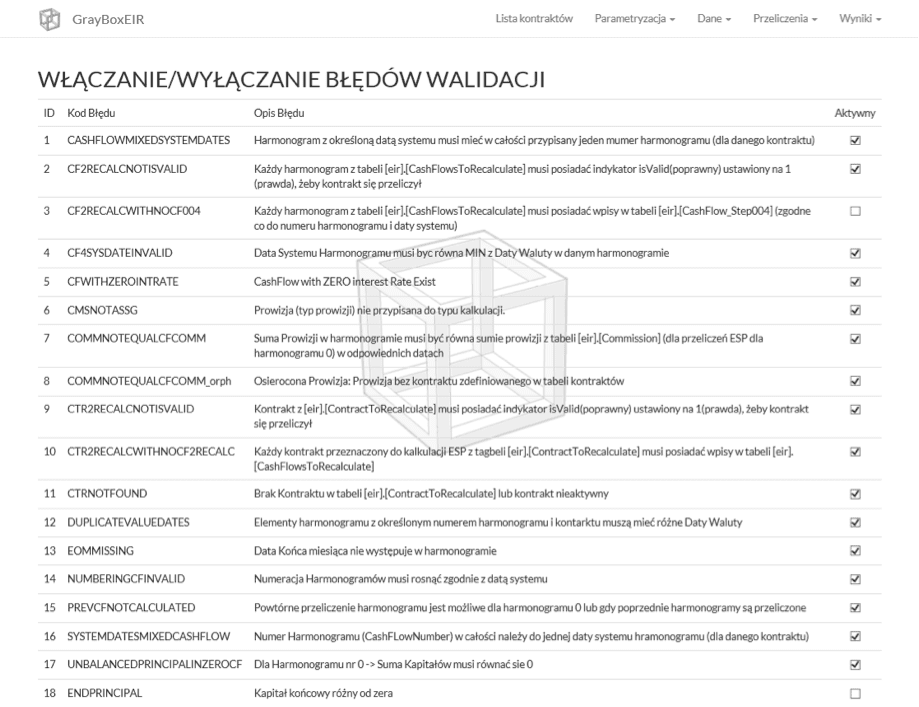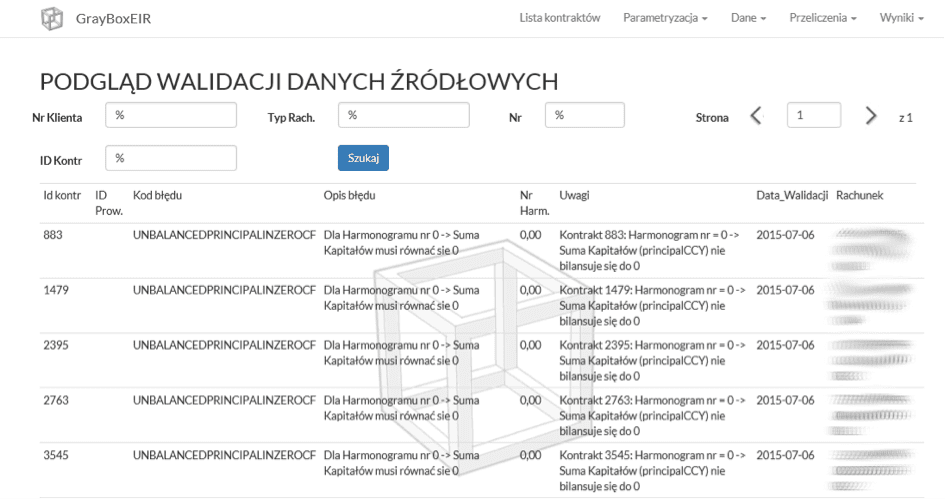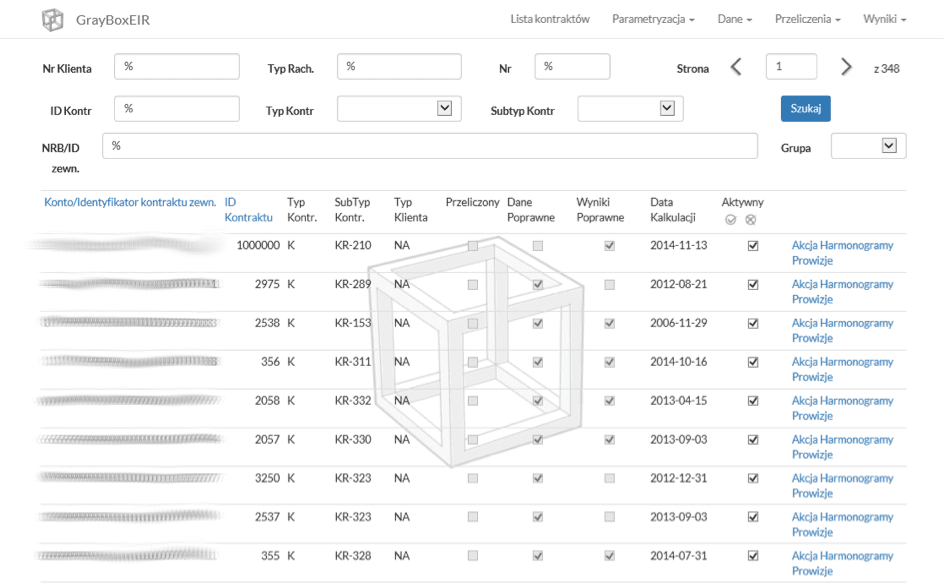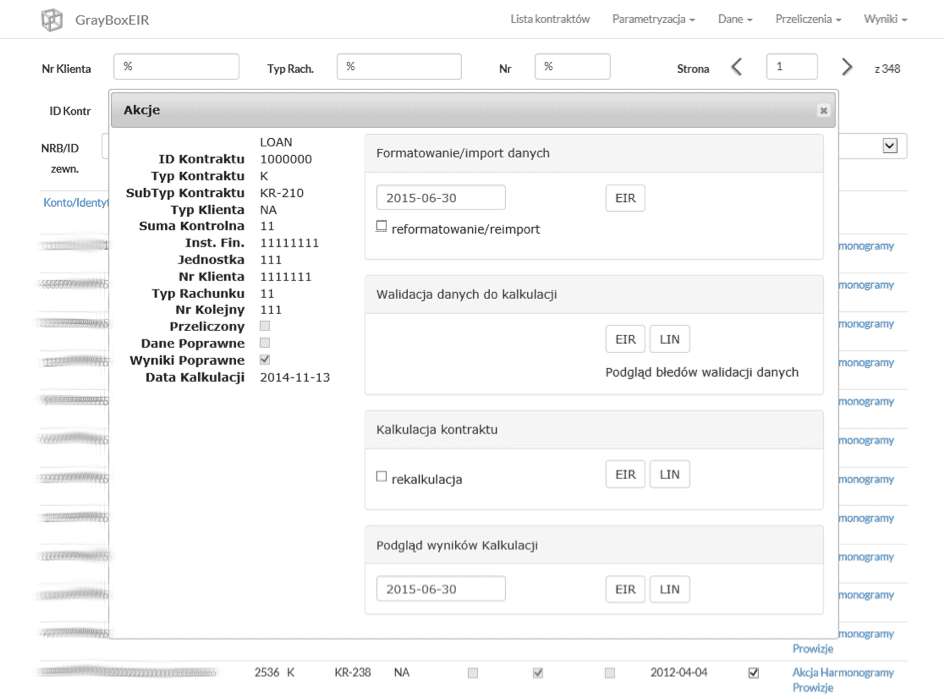WHY GrayBoxEIR

MULTIPLE PRODUCTS
The GrayBox system for EIR calculation supports credits, deposits and securities.

ADJUSTMENTS
An adjustment module allowing to correct the data in an auditable way.

SPEED
Optimised calculation algorithms, multithread processing.

ANALYTICS
Each posting has a correspondent in the recalculated contract and schedule.
The system has been designed within a modular architecture with differentiation of the database layers, processing and the user interface. Separate data collection, reporting and recalculation modules provide much flexibility in approaching specific executions and implementations. With GrayBoxEIR, data from many different organizational units can be simultaneously stored and processed in one database instance.
The database mechanisms applied in GrayBoxEIR make it possible to store historical data in the system, define easy access to data from the report or interface levels as well as import-export extracts to and from other systems. Additionally, with domain profiles, the system users can be identified and information on their key actions gathered for audit purposes and to provide a high level of data access security.
The parameter approach to many aspects of the system lets us customise the products so that they are adapted to individual users. Multithreading makes it possible to support multiple organisational units and even multiple simultaneous processes in processing the data of a single organisational unit.
We have used the dotNET technology to develop our user interface; all system features the user needs are accessible from the web browser.
You are welcome to contact us. We will be happy to demonstrate our new product.
ARCHITECTURE MODEL
A multi-layer architecture model that separates data, processes and user interfaces.
DATA COLLECTION & INTEGRATION MODULE
The data integration module is designed to extract the data needed to perform EIR recalculation. It uses information on contracts, schedules and other events leading to a recalculation, as well as current accounting balances (for the purposes of reconciliation of the posting results).
This module is a separate process within EIR and may be launched separately in relation to the entire EIR recalculation. With this solution and the fact that the data feed system is launched every day as part of the day closure process, we can avoid collecting accumulated data for the recalculation day and optimise the timing of the process. Another reason for daily launching is to extract data to simulate EIR recalculations.
Due to the diverse characteristics of source systems, this module is provided on a customised basis, its structure resulting from the local data structures and extraction capabilities.
RECALCULATION MODULE
Based on the data extracted by the Data Collection Module and parameter charts, this module recalculates the valuation of receivables and liabilities as per the adjusted purchase price calculated based on the effective interest rate, the recalculation resulting specifically in EIR adjustments for particular calendar days and the value of the accumulated EIR adjustment as calculated at the beginning of the respective schedule.
The module works on an iterative basis for each contract, from the oldest to the most recent schedule.
Such parameterisation helps to specify whether the contract shall be subject to recalculation and whether the recalculation shall be considered final. The process may be defined so that it either recalculates all schedules since the beginning of the contract life or only those that have not been subject to recalculation yet. (Recalculation of the entire contract is usually unnecessary, however, in specific cases such as supplementation of a schedule with a retroactive value date extending beyond the previous recalculation, recalculation of the entire result may even be indispensable.)
To accelerate the module operation, only certain features of the algorithm operate on a multithread basis.
The recalculation module supports the basic types of contracts such as credits or loans, deposits and securities.
POSTING GENERATION MODULE
This module generates postings for a specified day in accordance with defined rules.
Both incremental and full postings can be defined. This means that only changes to the EIR adjustment may be posted, or the posting may comprise two steps: derecognition of the previous adjustment and posting a new one (in this case, the balance sheets are easier to control, but much more turnover is generated on the accounts, however, all the adjustments are automatically recognised).
ADJUSTMENT MODULE
The GrayBoxEIR system also features an adjustment system adjusting the input data for the recalculations in a fully auditable way. Schedules altered with respect to the original one can be imported to the adjustment system.
Once the adjustments are defined, the recalculation module performs calculations with the data provided in the adjustments. Only input data may be adjusted, not the output, since this would prevent the entire system form balancing, making it impossible to reconcile the results.
SYSTEM PARAMETRISATION
System parameterisation consists in defining the types of contracts that require recalculation, the recalculation method (which schedules shall be recalculated, whether all schedules shall be recalculated or only those not subject to recalculation yet, according to EIR or in the straight-line method etc.), an option to exclude a contract from the recalculation mechanism or to exclude a contract from posting even though it has been recalculated.
The system also allows parameterisation of bookkeeping note generation: specific accounts and accounting rules can be defined, as well as posting narratives that will accompany the postings. Such data are introduced at the parameterisation stage of the Posting Generation Module.
As part of the posting process, also posting methods - synthetic or analytic - shall be defined as well as a possibility to reconcile total amounts with the analytics stored in the GrayBoxEIR system, especially in the case of synthetic postings.
Validation rules are also subject to parameterisation. Parameterisation is available from the user interface in an interactive form, it may also be available at the data extraction stage or as a separate import to the system if the user prefers to define the rules with their own tools, or as inquiries in the Bank's operating system if manual introduction of the rules would be time-consuming and involve the risk of operator's mistakes.
Organizational unit support methods as defined in the system are also subject to parameterisation. Recalculation may either be done collectively or cover only selected organizational units in each instance. At parameterisation stage, a decision shall be made as to the input and output data structures, for example the catalogues/folders where bookkeeping notes will be saved for each organisational unit shall be built and defined in the system.
DATA AND RESULT VALIDATION
Data validation takes place in several parts of the process:
- In the Data Extraction Module, e.g. the user can specify the label of the principal sum and whether the principal instalments level out to zero.
- In the Recalculation Module, as our algorithm considers the commission to be part of the accumulated EIR adjustment, the last accumulated adjustment shall always be equal to zero as long as the data gathered for the calculations are correct.
- In the Posting Generation Module - validation consists in defining those contracts for which no postings have been generated and which are not excluded from posting. Additionally, rules may be defined to identify labels on specific accounts as well as the completeness of each posting (balancing operations for each posting). The latter can be omitted if the postings are generated not as account operations but accounting rules later transformed by the accountant into operations.
- Furthermore, validation includes verification of the postings and/or output balances in the Bank's transaction system with the analysis results stored in GrayBoxEIR.
REPORT MODULE
The report module is based on the MSSQL Server procedures and the MSSQL Reporting Services module (we also make reports available through SharePoint), which provides sufficient capabilities of generating any reports and summaries. Adequate reports are generated once the needs of our clients are established together with the scope of the reported data. We also prepare the following reports as part of our standard services:
- aggregate data on valuation
- single contract valuation
- events that impact the calculation
- processing log
- report listing the contracts subject to recalculation
- report listing the contracts not subject to recalculation
- bookkeeping notes
- reconciliation of the bookkeeping notes with recalculated contracts
We also offer a simplified mechanism of making reports available via our SquareOne portal. The portal is based on browser mechanisms providing access to selected reports to selected users in a formal, menu-based way.
With the Reporting Services subscription mechanisms, the defined reports may be automatically sent to specified folders or to selected users by email.
DATA EXCHANGE MODULE
We can prepare a customised data exchange module by means of MSSQL Integration Services. This consists in keeping the GrayBoxEIR system independent of local systems while proving access to the data from that system to others, especially to the Data Warehouse.
Please find below a few examples of user interface screens. The interface appearance may be adapted to your applications and websites.







Are you interested in our offer?
Regardless of whether it is a large application supporting financial management, data warehouse or a simple report - we will do it efficiently and effectively!
